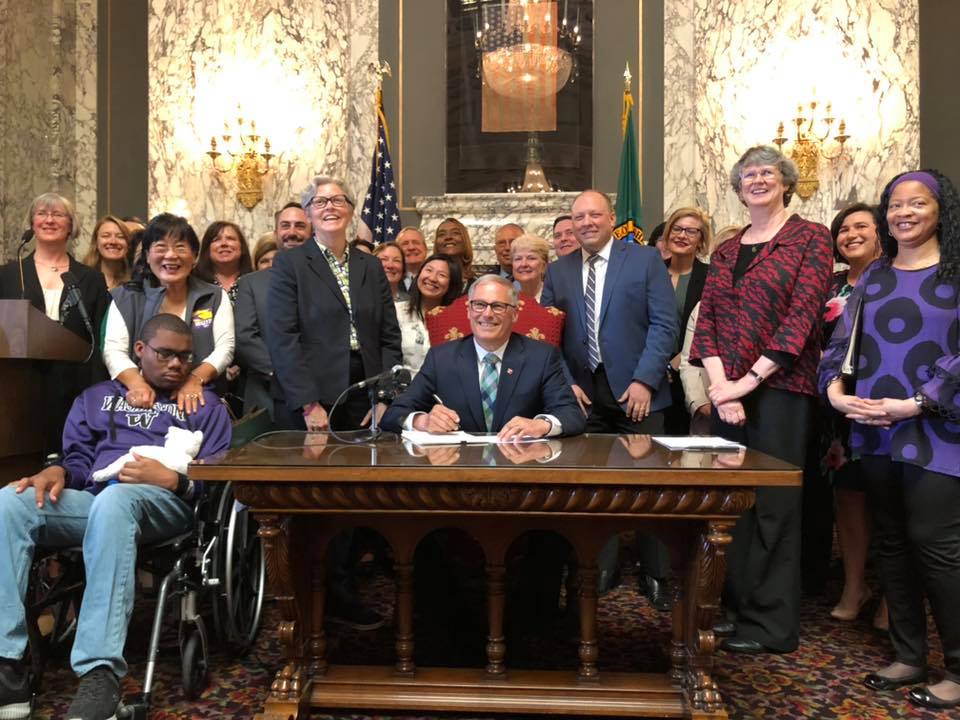We are proud to announce the launch of the CREATIVE CARE COUNCIL! LEARN MORE
We are proud to announce the launch of the CREATIVE CARE COUNCIL! LEARN MORE

News is flowing out from the Pacific Northwest about the passage of the Long-Term Care Trust Act! Signed into law yesterday, May 13th, 2019, it is a first-of-its-kind, publicly-funded long-term care program. It defrays up to $100/day in long-term care, services, and support costs.

This groundbreaking victory is an innovative public policy model for the rest of the country. It is the result of a bold vision for a better future coupled with a long-term dedication (more than 10 years) to grassroots organizing, policy and research, and relationship building. Without the dedication of organizers, leaders, and advocates on the ground, we would not be where we are today.
So what did we win in Washington and what opportunities does it open for care campaigns in other states? Washingtonians for a Responsible Future was the key coalition body that moved the Long-Term Care Trust Act across the finish line. Through this body, senior groups, illness-specific organizers, unions, and experts in the field came together to create a new social program for Washingtonians.
Lesson One: Washingtonians showed us that winning is possible.
We can create a new benefit. We can build a coalition powerful enough to push forward a different vision of the future. We can hold elected officials accountable to bold action. Winning is possible, working together is mandatory.
Since last year when AARP pulled out of the coalition very publicly, the organizers worked hard to repair trust, to workshop the bill language, and to ensure everyone moved forward together.
This year we saw a unified front. Activists on the ground published letters to editor, posted on social media, and called their elected officials to ensure their votes. Coalition partners held town halls and webinars with elected officials to see where they stood on the Long-Term Care Trust Act. This is a victory that was earned and shared by the coalition.
Lesson Two: The win in Washington showcases an innovative and sustainable model to support people’s changing care needs.
Financed by a small payroll tax, which is collected over an individual’s career and placed into the Long-Term Care Trust, a vested individual can pull $100 a day from the fund at any time in their life. The current program maxes out at $36,500 during a lifetime.
While this does not hit the full range of needs individuals experience (permanently disabled people, those who cannot return to the workforce after an injury, etc.), it does hit a huge segment of the need. It turns out that many people only need long-term care for less than a year during their lives. Moreover, the program’s success will give space for advocates to expand the program in the future to truly cover all Washingtonians.
Lesson Three: We learned that this is an issue we can organize and mobilize voters around.
People were activated and new people joined the Care Movement. Leaders like Ruth Egger, who was a caregiver for many people in her family, came to every hearing, gave testimony, and spoke to reporters. She did this work out of love, but she also acknowledged how hard it was, how she could have used respite support, how expensive everything was, even though she likely will never receive this benefit, she wanted a better future for others, as did many of the leaders that worked to pass this bill.
What’s Next? Building on the momentum.
Across the country, people are working to expand access and improve our care infrastructure. In New York State, the NY Caring Majority is pushing a single payer healthcare bill with long-term supports and services (even before Senator Sanders or Congresswoman Jayapal introduced their Medicare for All bills at the federal level). In Iowa, they are asking Democratic Presidential hopefuls what they plan to do to address our care crisis. In Wisconsin, they are fighting to expand Medicaid and raise the minimum wage for home care workers to $15/hour.
But we need everyone to take action, if you’re ready to join the movement click here now!